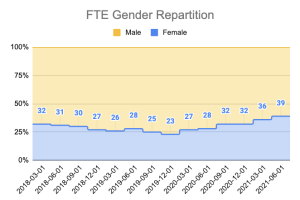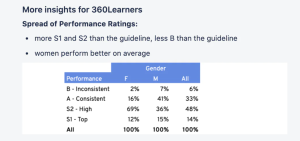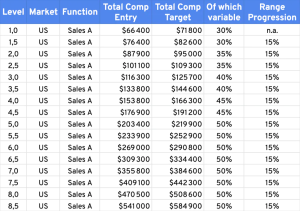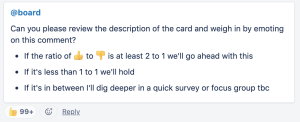“He makes how much?”
Discovering that a co-worker handsomely outearns you — even though you have the same job title and years of experience — leaves a bitter taste in the mouth. It’s the kind of thing someone might quit a job over, or at the very least, it’s certain to dampen the mood.
Yet keeping salaries, performance reviews, and rationales for promotions confidential is the norm at many workplaces. Unfortunately, not only can this cause unnecessary friction, but it can also breed bias and favoritism.
Likewise, it can slow down the recruitment process, since candidates understandably like to know salary ranges for positions before even applying. And in a remote work setting where communication can stagnate, it can leave employees feeling insecure and lost as to whether they’re “doing OK” compared to their colleagues.
At 360Learning, we made the decision to embrace radical transparency: Compensation, performance appraisals, and who’s up for a promotion are all public knowledge. We do this because it aligns with our company culture that’s based on trust among peers.
But we also do this because we believe it’s the only way to foster a healthy work environment, one where covert conversations, backbiting, and politics don’t warp how the company rewards employees.
Embracing Radical Transparency
A key advantage of radical transparency is that it keeps people accountable. It’s hard to get complacent when your compensation package and performance reviews are on full display. This transparency keeps employees sharp and accountable — nobody wants to seem like they’re hitching a free ride.
It also helps the company calibrate and get on the same page as to what high or adequate performance actually looks like. Breaking down ratings by geography, department, and other factors can help raise — and answer — questions that might otherwise generate silent frustration.
In addition, having one clear accessible source of data makes it easier for everyone to understand compensation outcomes for themselves and potentially for others they might want to benchmark against.
From Theory to Practice
How does all this pan out in practice? Not only are our salary grids in the public domain (more on that below), but so are our quarterly performance reviews, levels (seniority grades), and promotion statuses.
That means that at any point, any employee can look up the level, salary, and bonus achievements of any employee by name. You can even filter that information by managers and their people to see data across a team.
As a result, this kind of transparency limits bias and favoritism, whether implicit or explicit. You can view the performance track record of anyone up for a promotion, and teammates can calibrate how their effort computes into assessment and bonuses.
Also, anyone can run the numbers around DEI issues like gender parity. For example, here’s a detailed breakdown of the of men vs. women hired at 360Learning, shared at a recent all-hands meeting:

And here’s a breakdown of performance based on gender (“B” are lowest performers, while “S1” are highest):

Great for Recruitment
Being open about salary saves precious time during the recruitment process, and can pique the interest of hard-to-find profiles. Plus, job applicants like salary transparency. Since we pride ourselves on paying competitively (70th percentile in the tech market), promoting our compensation model is also a sound recruitment tactic to attract top talent. For instance, here’s what our U.S. Sales salary range looks like:

What’s more, we don’t negotiate salaries with candidates. As we wrote in this blog post:
“Unlike what happens in many organizations, our salary ranges aren’t just a soft guideline that falls apart whenever reality comes knocking on the door: they are law. When the yearly Compensation Reviews come up, our salaries are calculated, not negotiated…As a 360Learner, you can compute your own raise!”
Radical transparency around pay and performance also provides an unambiguous path for professional development. That is, feeling stuck in a rut is a huge reason for employee churn. But when you can see exactly what it would take to move up at your current company — and what the financial benefit might be — it’s easier to get motivated to earn a “Level-Up” (promotion into a higher pay grade) instead of looking for opportunities elsewhere.
Openings for Leveling Up happen twice a year, and yup, you guessed it: Those who are up for promotion are highlighted in our shared performance appraisal file.
The bottom line is that transparency around compensation, performance, and promotions makes it much easier to create a fair working environment. Not only does confidence in your employer’s fairness increase motivation and reduce employee turnover, it can also mitigate burnout. Sure enough, a 2018 Gallup poll found that “unfair treatment at work” was a leading cause of burnout.
Transparency Toolkit
So what does it actually take to create this kind of culture of transparency? Our People team has spent considerable time honing the processes they need to make this system work. Part of this has entailed having a clear performance appraisal system.
It’s great to make your performance reviews transparent. But if the actual review process and criteria themselves are arbitrary, you’ll lose all that hard-won credibility. That’s why we use a combination of the Objectives and Key Results (OKRs), clearly defined scopes, and metrics-driven KPIs to assess performance.
Furthermore, setting the OKRs is both a bottom-up and top-down exercise; coaches and individual contributors should be aligned, and teams notify each other with their proposed objectives. In this way, everyone’s targets and achievements are consistent, metrics-driven (not subjective), and linked together to contribute to a common company vision.
The Employee Perspective
At this point, you might be wondering whether this radical transparency leads to any awkwardness. Do employees actually enjoy having this kind of information laid bare?
We admit that if this level of transparency makes some people anxious, then our company might not be the best fit for them. But among our current employees, the feedback is more than encouraging. Not only have we recently achieved our highest employee satisfaction score to date (a 9 out of 10, way above the industry standard) but our turnover rate has also decreased.
We should also note that we didn’t make our performance review information public without first asking our employees what they thought. As you can see below, support for the idea was unanimous:

Transparency in the DNA
Ultimately, we want to attract the kind of candidates who will thrive in this environment, firstly because it’s in our company DNA, but also because it leads to an overall more healthy and productive company culture. While these sorts of practices might take certain employees (and employers) some getting used to, we’re confident that transparency is the best means to cultivate a motivated, effective, and happy workforce.
